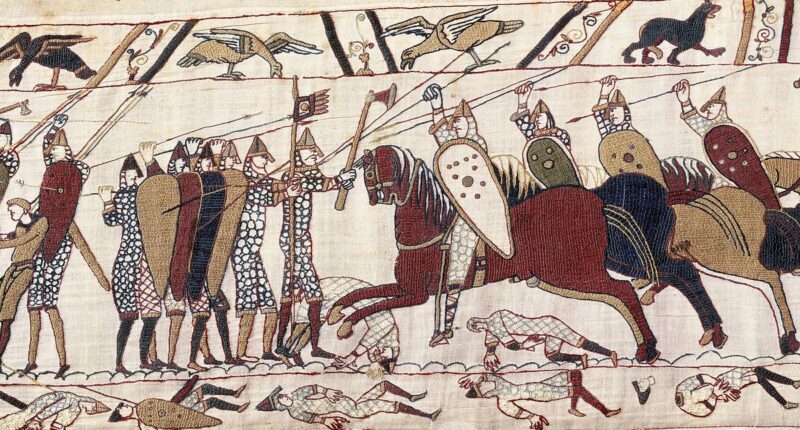Share this @internewscast.com
The Bayeux Tapestry cannot be moved without it tearing, a French historian opposed to its loan to the British Museum has said.
Didier Rykner spoke out as a petition he started on Change.org calling for the move to be cancelled reached nearly 50,000 signatures.
The 11th-century work depicting the 1066 Norman Conquest is to go on display in Britain next year.
The historic loan was announced in June by French President Emmanuel Macron during his visit to Britain.
However, Mr. Rykner shared on BBC Radio 4’s PM programme yesterday, stating, ‘I’ve communicated with the experts involved with the tapestry, and they consistently report the same concern. It’s extremely delicate.’
‘You have to understand, it’s 70 meters in length. It is exceedingly lengthy, composed of a very thin canvas… and moving it would undoubtedly pose a risk of damage, tearing, or puncturing.’

The Bayeux Tapestry cannot be moved without it being damaged, a French historian opposed to its loan to the British Museum has said

Didier Rykner spoke out as a petition he started on Change.org calling for the move to be cancelled reached nearly 50,000 signatures
The expert insisted that if it were possible to move the treasure without it being put at risk, he would agree to the loan.
Amidst some specialists’ worries over transporting it across the Channel, the British Museum has maintained that their experts possess significant experience with handling delicate artifacts.
Yet, Mr. Rykner, who edits the art history website La Tribune de L’art, expressed, ‘I feel quite let down by the British Museum, as they are well aware that they’ve never relocated anything of this nature before.’
‘It is unique. It is a work of art from the 11th century. It is impossible that they know how to do this.’
The tapestry, presently exhibited in its dedicated museum in Bayeux, already shows roughly 24,000 stains, 16,445 folds, nearly 10,000 holes, and about 30 tears.
Mr. Rykner’s petition, written in French, states: ‘It was these very individuals who were responsible for evaluating it, determining its condition, proposing the necessary precautions for its safeguarding during the development of the new museum, and analyzing the hazards of potentially transporting it to England.’

The 11th-century work depicting the 1066 Norman Conquest is to go on display in Britain next year. Above: The embroidery at its permanent home, the Bayeux Tapestry Museum in France
‘Their diagnosis is unequivocal: any transport, however minimal, represents a danger.’
The Bayeux Tapestry depicts the events leading up to the Norman Conquest of England, led by William, Duke of Normandy challenging Harold II, King of England.
It is believed to have been woven in the UK.
When the artefact returns to Britain, Anglo-Saxon treasures from the Sutton Hoo ship burial will go in the other direction to France for a temporary period.
Mr Macron revealed during his trip to Britain last month that King Charles helped secure a deal to return the tapestry to England.
He claimed France did its best not to loan the artwork but that His Majesty helped get the deal over the line.
Despite its name, the treasure is in fact an embroidery rather than a tapestry.
Tapestries are usually woven using a loom, while embroidery is traditionally made with a needle and thread
















